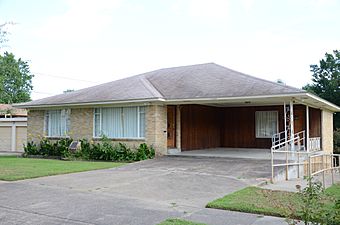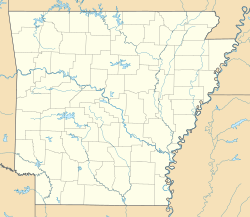Daisy Bates House facts for kids
|
Daisy Bates House
|
|
 |
|
| Location | 1207 West 28th Street, Little Rock, Arkansas |
|---|---|
| NRHP reference No. | 01000072 |
Quick facts for kids Significant dates |
|
| Added to NRHP | January 3, 2001 |
| Designated NHL | January 3, 2001 |
The Daisy Bates House is a special historic home located at 1207 West 28th Street in Little Rock, Arkansas, USA. It was the home of Daisy Bates, who led the Arkansas chapter of the National Association for the Advancement of Colored People (NAACP). This house was a very important meeting place and a safe spot for the people working to end segregation in schools.
It played a key role during the 1957–1958 crisis when nine brave African-American students, known as the Little Rock Nine, tried to attend Little Rock Central High School. The Daisy Bates House was like a headquarters for their efforts and a safe haven for these students. Because of its important history, it was named a National Historic Landmark in 2001.
Contents
What Does the Daisy Bates House Look Like?
The Daisy Bates House is in a neighborhood south of downtown Little Rock, Arkansas. It's a typical one-story house from the 1950s, known as a ranch house. The house is about 39 feet (12 meters) long and 51 feet (16 meters) wide.
It is built with a wooden frame and has a brick outside. The roof is sloped and has wide edges. These wide edges also cover a carport, which is a covered area for cars, on the north and west sides of the house. Both the foundation and the carport floor are made of concrete.
The front of the house, which faces north, has two large windows with smaller windows next to them. The main door to the living room is inside the carport. There is also another door to the kitchen from the carport. Inside, the house has a common layout for a ranch home. It has a living room, dining room, and kitchen. A hallway leads to two bedrooms and two bathrooms. The basement is partly finished with a recreation room and a small bathroom. The attic is also finished and can be reached by pull-down stairs.
Who Was Daisy Bates?
Daisy Lee Gatson Bates (1914–1999) was a very important leader in the Civil Rights Movement. In 1952, she became the president of the Arkansas NAACP. She also started a newspaper called the Arkansas State Press. This newspaper worked to support the civil rights of African Americans in Arkansas.
In 1955, Daisy Bates and her husband, Lucius Christopher Bates, bought this new house at 1207 West 28th Street. This house would soon become a center for change.
Why Was the Daisy Bates House So Important?
In 1954, the Supreme Court of the United States made a big decision called Brown v. Board of Education. This ruling said that public schools across the country had to end segregation and allow students of all races to attend together.
In Little Rock, the school superintendent, Virgil Blossom, created a plan in 1955 to integrate the city's schools. However, the NAACP felt the plan was not strong enough. They filed a lawsuit in 1956 because the plan did not say exactly when integration would happen. This made Mrs. Bates well-known in the area.
The Little Rock Nine and the House
Following the school's plan, the NAACP chose nine African-American students to attend Little Rock Central High School in 1957. This was the first time the city's schools would be integrated.
On August 27, 1957, someone threw a rock through the Bates' front window. A note attached to it said, "STONE THIS TIME. DYNAMITE NEXT TIME." This showed the danger and anger many people felt about integration.
The students were supposed to start school on September 4. The days leading up to this were full of tension and legal battles. On September 2, Governor Orval Faubus called out the Arkansas National Guard. He wanted them to stop the students from entering the school.
Mrs. Bates worked as a go-between for the nine students and the school board. She attended a school board meeting for the students on September 3. The next morning, she arranged for a group of ministers, both white and African-American, to walk with the students to the school. However, the National Guard turned the students away. A large, angry crowd of white people surrounded them.
Worldwide Attention and Safety
This event caught the attention of news reporters from all over the world. The Bates house became the main place where reporters went to hear the "black perspective" on what was happening. One student, Elizabeth Eckford, whose picture in the crowd became very famous, stayed at the Bates house that night. Security was arranged to keep everyone safe.
After more court actions, September 23 was set as the new date for the students to enroll. The students and their parents met at the Bates House that morning. They traveled to the school, where more than 1,000 angry people were gathered. Despite police protection, the students could not enroll and had to return to the Bates house.
Because of this and the ongoing threats, President Dwight D. Eisenhower took control of the Arkansas National Guard. He also sent soldiers from the 101st Airborne Division to Little Rock to make sure the integration orders were followed.
On the morning of September 25, the students met again at the Bates house. They were then escorted to the school by soldiers from the 101st Airborne and finally enrolled. That day, and many times throughout the school year, the nine students met at the Bates house. They talked about how they were being treated at school and how best to deal with it.
The house continued to have police protection. Mr. Bates also organized informal security. Even with this protection, crosses were burned in the yard twice. Shots were also fired through the windows from cars driving by. In July 1958, Mrs. Bates was even hung in effigy in Ouachita County, Arkansas.
The Little Rock School Board tried to stop integration by closing all its high schools for the 1958–59 school year. Not long after this closure, the Bates house was attacked with a firebomb. The schools reopened in 1959, again with a small number of African-American students. The Bates house once more served as their meeting point.
Images for kids




